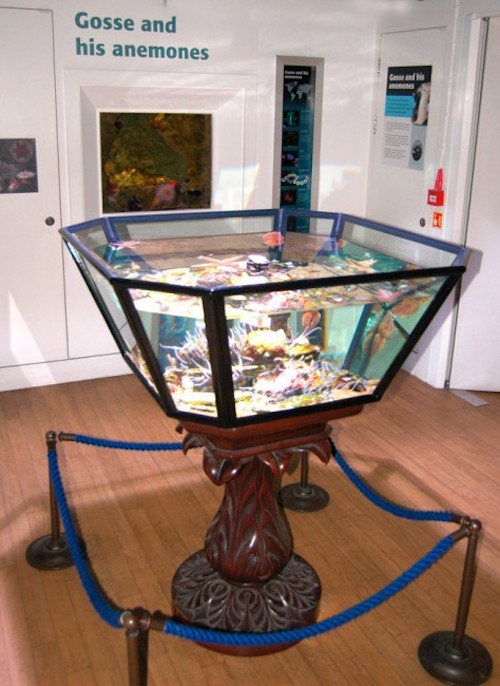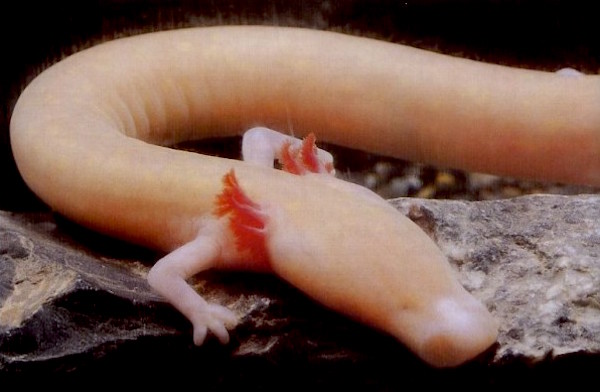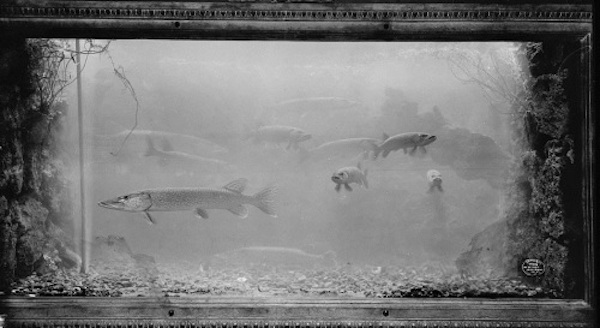In this ongoing series, we ask SF/F authors to describe a specialty in their lives that has nothing (or very little) to do with writing. Join us as we discover what draws authors to their various hobbies, how they fit into their daily lives, and how and they inform the author’s literary identity!
When I was small, my first reaction to seeing the sea was to run straight into it, until my feet lost the bottom and my head went under.
The only way my parents could stop me was to tell me the ocean swarmed with monsters: blue sharks and makos, cruising in wait just yards from shore.
I became terrified of the sea, but obsessed with its leavings. The crab shells, the shrimps, the jellyfish. The dead cod that washed up one long August, and which I dragged aimlessly for a mile or so up the beach before burying in disgust.
Dad would go fishing in lakes, and I would rush over to examine his catches, to breathe in the weird ozone tang of their slime. But even the ponds made me uneasy; every shadow concealed a six-foot pike, with demon eyes and needle teeth, and I dreaded the thought of putting even a finger into the murk.
When I first visited an aquarium, though, I was enchanted. All the threatening opacity was gone: the monsters were at bay behind glass, and I could look in at them in their element.
Much later, writing my dissertation on the effect of the glass aquarium on Victorian culture (it’s more interesting than you think), I realised my feelings about aquariums had once been a national obsession: the popularity of the “Wardian case” (a miniature greenhouse for cultivating sensitive plants) in the 1840s inevitably led to someone turning one upside down, filling it with water, and bunging some fish in it. Aquarium pioneer Anna Thynne kept madrepores (a sort of coral) in central London in 1847—and kicked off both a craze for sea life among high society, and a series of debates around evolution, philosophy, religion and sexuality.
And with the repeal of the glass tax in 1851 (the same year an aquarium featured at the great exhibition—itself held in a massive glass palace), the aquarium buzz spread to the public at large. London Zoo got its own aquarium in 1853, (stocked by Philip Henry Gosse, the man who coined the name), and aquamania ran wild across Europe.

Alien Worlds, and People Turning into Salamanders
For the first time, people could view the underwater world in cross-section: they could look into an alien world. The cultural impact was immediate.
In his history of paleoart Scenes from Deep Time, Martin J S Rudwick explains how naturalists went from reconstructing prehistoric sea life washed up on beaches, to drawing them under the waves, in life.
The effect on literature, however, was properly odd.
Proteus Anguinus, or the olm, is a weird animal. It’s found in the deep underground waterways of Slovenia, where it may live 100 years in silence and darkness. It is eyeless, pitiably thin, and regularly goes years without eating. It’s also neotenic, meaning it never leaves its childhood larval form, and in Slovenia they call it “človeška ribica” or Human Fish, due to its pale, slender form and gracile limbs.
(I love olms so much I paid Tarn Adams, the developer of Dwarf Fortress, to code them into his infamous game.)
Around 1861, a consignment of olms made it to Britain, where they were viewed in a Zoological Society aquarium (or so my research suggests) by close correspondents and natural history giants Charles Darwin and Charles Kingley. Darwin immediately wrote them into the next edition of The Origin of Species, but Kingsley did something a bit more… well, chilling.
In his 1863 book The Water-Babies, protagonist Tom is a chimney sweep—a child made wretched through labour in a grimy, industrial world. Early in the book, he drowns in a river, and is reborn as a strange larval creature described by Kingsley as resembling Proteus. The fact that the story is about a kid who dies and lives a weird afterlife as an emaciated blind salamander (“človeška ribica”) is only the beginning of how profoundly eerie The Water-Babies is (believe me, I wrote a dissertation on it)—but it’s a great example of how aquariums messed with the Victorian imagination.
(The Water-Babies isn’t even the only aquarium-inspired story about someone turning into a neotenic salamander, by the way. See the short story Axolotl by Julio Cortázar for another weird look into this convolution of spiritus mundi. Or the bit in Earthworm Jim 2 where the protagonist inexplicably becomes an olm. I’m not making this up).
The point here is that aquariums have the power to disturb. From the religious and even sexual confusion experienced by Thynne’s guests as they observed her aquarium, to the evocation of the olm in Kinglsey, they elicit strange feelings because they reveal an alien world—they show people things they were literally never meant to see.

The Zombie Goldfish
That revelation commands a high price, however. In maintaining a small piece of the sea or a lake in a glass box, you are attempting to isolate and suspend a fragment of a greater system—you’re trying to cheat death.
Let a cheetah’s cage get dirty and you’ll end up with a sad, vile-looking cheetah. Let a fishtank get dirty and its occupants will, in effect, have to breathe their own faeces. Things go wrong quickly in aquariums. And when they do (it’s usually a case of “when” rather than “if”), it’s not something you want a window into.
In my teens, I took a job working in an aquatics shop at weekends—it was a great way to feed my fascination with watching the underwater world. Unfortunately though, it was a really, really bleak aquatics shop. Its labyrinth of tanks was working off a decrepit pump and filter system devised in the 1970s, and which was reputed to be infested with eels. It was the Millennium Falcon of fish tank setups, and I was its hapless Chewbacca. Breakdowns were frequent, fish would die on arrival, and I became accustomed to seeing their bodies tumbling lifelessly in the current.
Worse yet, as the weekend kid (and so lowest in the pecking order), I was given the job of dispatching any fish that arrived ill, and which the boss didn’t want on display to the public. It really upset me.
Then one spring, the worst thing happened. Cleaning out some outdoor tanks that had been boarded up since September, I discovered a goldfish that had accidentally been left in over winter. It had developed an ulcer, which had by now eaten away half its side, leaving bone and organs exposed. The thing had been circling there all winter, in the dark, slowly coming apart.
The nightmares started not long after that. Fifteen years later, I still get them most weeks. I’ll be dreaming of a fishtank that seems normal at first, but which becomes increasingly full of decay, monstrosity and death if I stare too long. On reflection, I really should have quit that job.
Can’t Get Enough
But all the grim stuff that happened in that fish shop couldn’t stop me from being fascinated by aquariums, and the chance to glimpse the alien.
At university I studied the history of science, and particularly the impact of natural history on industrial cultures. After I graduated, I worked for a while at a public aquarium—which in truth, wasn’t a whole lot less grim than the aquatics shop. If you go drinking with me, the stories about that place soon come out. But I stayed keen. I began to keep my own aquariums, housing everything from crabs to clawed frogs, and axolotls to mole shrimps. I went on to swim in the Amazon, to grapple catfish in Oklahoma, to get my PADI and dive in open water.
Even as I write, I’m sizing up a corner of my new house for the installation of a new tropical tank, and I still visit aquariums most months. Soon, I want to travel to see Proteus breeding in an aquarium deep in its karstic home.
The nightmares haven’t stopped. Sometimes in aquatics shops I get short of breath and confused, and the sight of a dead fish can bring tears and shaking. But I just can’t stop looking.

Running into the Sea
Those who’ve read my work probably aren’t surprised by any of this. My debut book, The Sea Hates a Coward, was about prisoners who, after their execution, are reanimated to work aboard a gargantuan factory ship on a vast, monster-haunted ocean. Its sequel, Grand Amazon, continues their story in a different setting—an endless river, teeming with tropical life and fevered decay.
I’m sometimes described as a horror writer, but (at least so far), I’m trying to write stories about how people find strength together to deal with things like despair, uncertainty and fear. Inevitably, given my own mental landscape, that involves quite a lot of fish.
Top image: Jurassic World (2015)
 Nate Crowley is a writer from South East London. He was picked up by Rebellion Publishing after tweeting about his mate’s birthday in a joke that went on so long it was nominated for an award. As well as his debut novella The Sea Hates A Coward, he has recently published its sequel Grand Amazon, and is currently working with Failbetter Games to produce Big Mike Lunchtime’s Business Training ‘95, a narrative game best euphemised as “a bit like Jumanji, but with businessmen.” If you want to talk to him about animals or the like, he is @frogcroakley on Twitter.
Nate Crowley is a writer from South East London. He was picked up by Rebellion Publishing after tweeting about his mate’s birthday in a joke that went on so long it was nominated for an award. As well as his debut novella The Sea Hates A Coward, he has recently published its sequel Grand Amazon, and is currently working with Failbetter Games to produce Big Mike Lunchtime’s Business Training ‘95, a narrative game best euphemised as “a bit like Jumanji, but with businessmen.” If you want to talk to him about animals or the like, he is @frogcroakley on Twitter.









